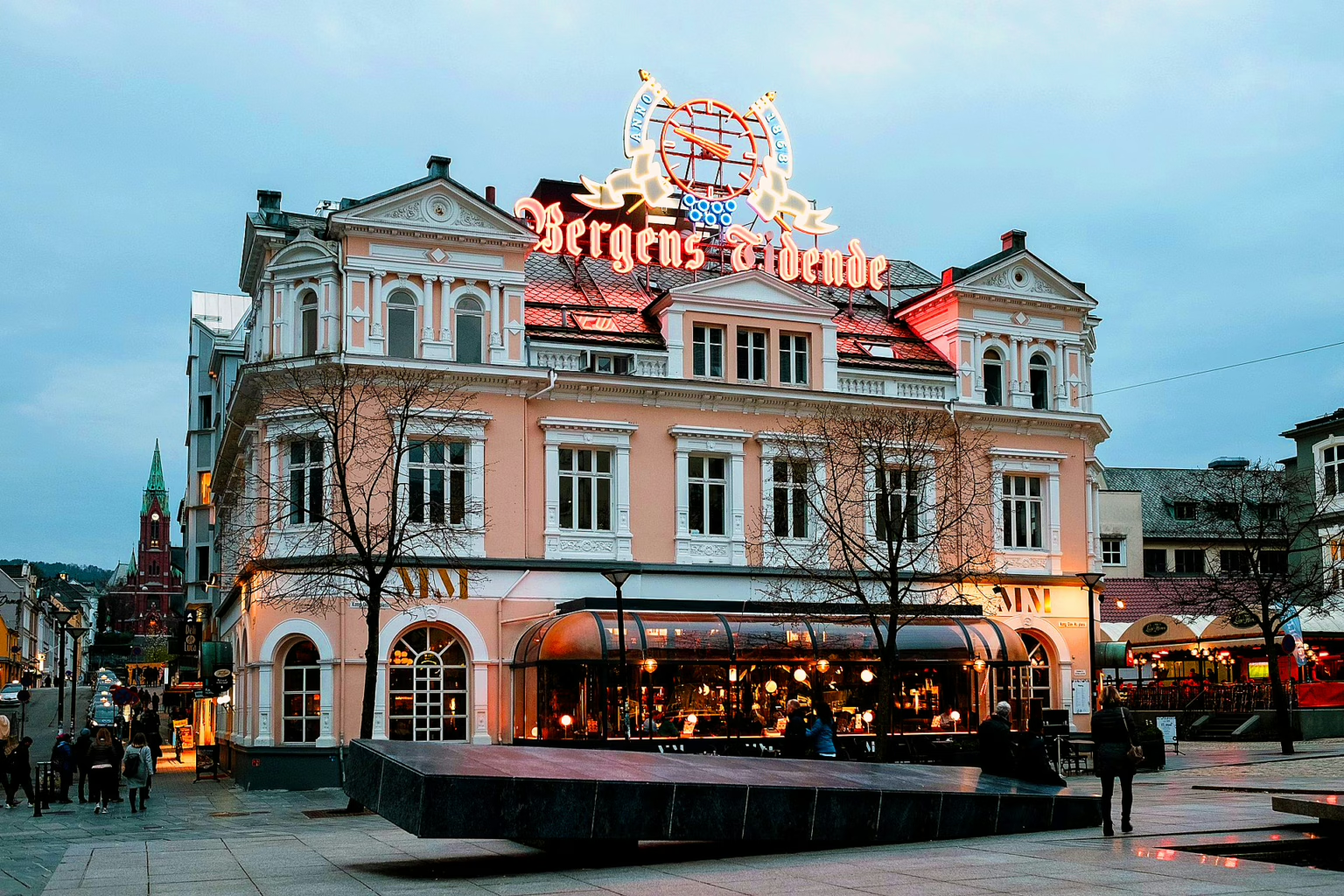-
Bergen, Norway
Tucked between dramatic fjords and mountains on Norway’s west coast, Bergen looks like it was plucked from an enchanted story. Known as the “Gateway to the Fjords,” this coastal city has long played second fiddle to Oslo. But what it lacks in size, it makes up for with raw natural beauty and rich cultural depth.
Bergen is a UNESCO City of Gastronomy, a recognition that speaks to its seafood scene, which rivals any coastal city in Europe. Locals shop at the bustling fish market, and restaurants like Lysverket elevate cod and langoustine into art. Beyond the plate, Bergen’s vibrant art scene includes the KODE museum cluster, showcasing Edvard Munch paintings and contemporary Scandinavian design. And if you are looking for outdoor adventure, the Fløibanen funicular brings you to panoramic hikes in minutes.
The city’s wooden houses in Bryggen, a Hanseatic Wharf dating back to the 14th century, add a layer of history that feels alive. Add the almost unusual weather, rainy and moody one moment, crisp and golden the next, and Bergen becomes the kind of place that lingers in your psyche.
-
Guanajuato, Mexico
While tourists often flock to San Miguel de Allende or Mexico City, the colonial city of Guanajuato offers a colorful and less-discovered alternative. Nestled in a narrow valley, its winding alleys, underground roadways, and vibrant houses create a visual feast.
Guanajuato is steeped in cultural richness. It’s the birthplace of muralist Diego Rivera and home to the annual Festival Internacional Cervantino, one of Latin America’s most prestigious arts festivals. The city also has a haunting allure, its famous Museo de las Momias showcases naturally mummified bodies found in nearby crypts, giving visitors a glimpse into Mexico’s complex relationship with death.
But it’s the street life that steals the show. Mariachi music echoes through plazas, and street vendors serve up gorditas and elote to locals and students from the nearby university. The city has a lived-in authenticity that invites you to slow down and stay awhile.
-
Porto, Portugal
Often overshadowed by Lisbon, Porto is a soulful city built on steep hillsides along the Douro River. With its azulejo-tiled buildings, port wine cellars, and medieval lanes, Porto offers old-world European charm without the crowds.
Start at Livraria Lello, one of the most beautiful bookstores in the world, and said to have inspired parts of J.K. Rowling’s Harry Potter series. Then stroll across Dom Luis I Bridge for river views that rival those of Paris. The Ribeira district is postcard-perfect, but Porto’s creative energy shines brightest in its lesser-known neighborhoods like Bonfim, where street art, co-working spaces, and cafes are bringing new life to old warehouses.
Port wine, of course, is central to the city’s identity. Tour a wine cellar in Vila Nova de Gaia and sip aged tawny ports as the sun sets over the river. It’s a city that pairs history with a low-key buzz—romantic, slightly gritty, and effortlessly cool.
-
Luang Prabang, Laos
Luang Prabang is a slow-paced, spiritual haven tucked into the mountains of northern Laos. A former royal capital and UNESCO World Heritage site, it’s a unique blend of Buddhist tradition, French colonial architecture, and natural beauty.
Here, saffron-robed monks walk quietly through the streets at dawn during the alms-giving ceremony. Days begin with strong Lao coffee and end with Mekong River sunsets. In between, visitors explore waterfalls like Kuang Si, cycle through nearby villages, and browse vibrant night markets for handwoven textiles.
What makes Luang Prabang truly special is the sense of time suspended. It doesn’t rush you. Instead, it invites contemplation and connection—the kind of travel experience that leaves you changed.
-
Tbilisi, Georgia
Georgia’s capital is a city of contrasts and resilience. With its eclectic architecture, Persian-style bathhouses, brutalist Soviet blocks, and sleek modern towers, Tbilisi feels like a place that embraces its complex history while hurtling toward the future.
The city’s old town is a maze of cobbled streets, balconies draped in grapevines, and tucked-away cafes where you can try khinkali dumplings and homemade wine. The hospitality here is legendary, and it’s not uncommon to be invited to a supra (Georgian feast) by people you’ve just met.
Over the past decade, Tbilisi has emerged as a creative and tech hub in Eastern Europe, with design studios, electronic music clubs, and fashion boutiques cropping up in former factories. It’s a city that’s gritty and gorgeous in equal parts—and still flying under the radar.
-
Valparaíso, Chile
Valparaíso isn’t tidy or polished, but that’s part of its magic. Often called “The Jewel of the Pacific,” this Chilean port city spills over steep hills, with bright murals, graffiti, and crumbling mansions lending it a bohemian, lived-in feel.
It was once the most important port on the Pacific coast of South America, and remnants of its golden age mix with the energy of its current artistic renaissance. Pablo Neruda once called it home, and his house, La Sebastiana, offers sweeping views of the harbor and the poet’s whimsical collections.
What sets Valparaíso apart is its unapologetic creativity. You don’t just view the street art—you wander through it, like walking inside someone else’s dream. Take a century-old funicular up the hills, or sip pisco sours in a clifftop bar overlooking the sea. It’s messy and magnificent.
-
Brno, Czech Republic
Overshadowed by Prague, Brno (pronounced bur-no) is the Czech Republic’s second-largest city and a rising star in the heart of Moravia. It balances innovation and heritage with surprising ease.
Brno has a thriving tech sector and university-driven energy, but its medieval roots are on full display in spots like Spilberk Castle and the Gothic Cathedral of St. Peter and Paul. Cafes and wine bars fill cobblestone squares, and the city is known for its underground labyrinth of tunnels and cellars, some dating back to the 13th century.
Its culinary scene is refreshingly inventive. Think Moravian wines paired with dishes that blend Central European traditions with modern flair. And with far fewer tourists than Prague, Brno feels both cosmopolitan and undiscovered.
-
Puebla, Mexico
While many travelers opt for Mexico City or Oaxaca, Puebla offers an intoxicating blend of history, flavor, and architectural splendor that deserves a spotlight of its own. Nestled in a valley beneath the towering Popocatépetl volcano, Puebla is one of Mexico’s oldest and most beautiful colonial cities.
Its historic center, a UNESCO World Heritage site, is a visual feast of baroque churches, vibrant talavera-tiled buildings, and charming courtyards. The city’s Cathedral, built in the 16th century, looms over the Zócalo with a regal presence, while the nearby Biblioteca Palafoxiana—the first public library in the Americas—invites book lovers into a baroque sanctuary of rare manuscripts and wood-carved shelves.
But Puebla’s soul is perhaps best expressed through its food. The city is the birthplace of mole poblano, a complex, velvety sauce made from chiles, chocolate, and spices. Street vendors serve up cemitas (loaded sesame-seed sandwiches) and chalupas with pride, and you’ll find some of Mexico’s most revered gastronomy in humble local kitchens.
Just outside town lies the Great Pyramid of Cholula—larger in volume than Egypt’s—and topped with a Spanish colonial church. It’s a powerful symbol of the city’s layered identity: ancient, colonial, and vibrantly modern all at once.
-
Kaohsiung, Taiwan
Taipei may get the headlines, but Taiwan’s southern port city of Kaohsiung is emerging as a bold, colorful, and utterly fascinating destination. Once an industrial hub, Kaohsiung has transformed into a cultural powerhouse with waterfront parks, futuristic architecture, and a warm subtropical vibe.
Start at the Pier-2 Art Center, a revitalized warehouse district filled with murals, pop-up installations, and cafes that blend Taiwanese creativity with industrial edge. The Dome of Light, the world’s largest glass art installation in a metro station, makes public transit feel like a spiritual experience.
For food lovers, the Liuhe Night Market is a whirlwind of sizzling seafood, bubble tea, and Taiwanese snacks like gua bao (pork belly buns). And just a ferry ride away, Cijin Island offers seafood feasts and a laid-back beach vibe, complete with an old lighthouse and black-sand shores.
Kaohsiung is also embracing sustainability and wellness. The sprawling Weiwuying National Kaohsiung Center for the Arts, shaped like a banyan tree canopy, is one of the largest performance spaces in Asia. Meanwhile, bike trails along the Love River and up Monkey Mountain provide scenic escapes without leaving the city.
It’s a place where traditional temples sit alongside sleek skyscrapers, and where locals greet you with genuine warmth. Kaohsiung isn’t just underrated—it’s redefining what a modern Asian city can be.
TL;DR: 9 Underrated Cities to Explore
- Bergen, Norway: A moody, magical fjord-side city with a world-class food and art scene
- Guanajuato, Mexico: A kaleidoscope of culture, color, and haunting history
- Porto, Portugal: Where riverfront beauty meets literary lore and port wine heritage
- Luang Prabang, Laos: A spiritual retreat wrapped in waterfalls, temples, and timelessness
- Tbilisi, Georgia: Gritty and graceful, a Eurasian city alive with warmth and creativity
- Valparaíso, Chile: A graffiti-covered gem of poetic chaos and coastal charm
- Brno, Czech Republic: A student-fueled, wine-loving, tech-savvy city waiting to be discovered
- Puebla, Mexico: Colonial splendor, culinary depth, and the soul of Mexico in every street
- Kaohsiung, Taiwan: A revitalized port city with bold art, night markets, and tropical flair
Let me know if you’d like help creating a lead image or infographic for this piece!
















